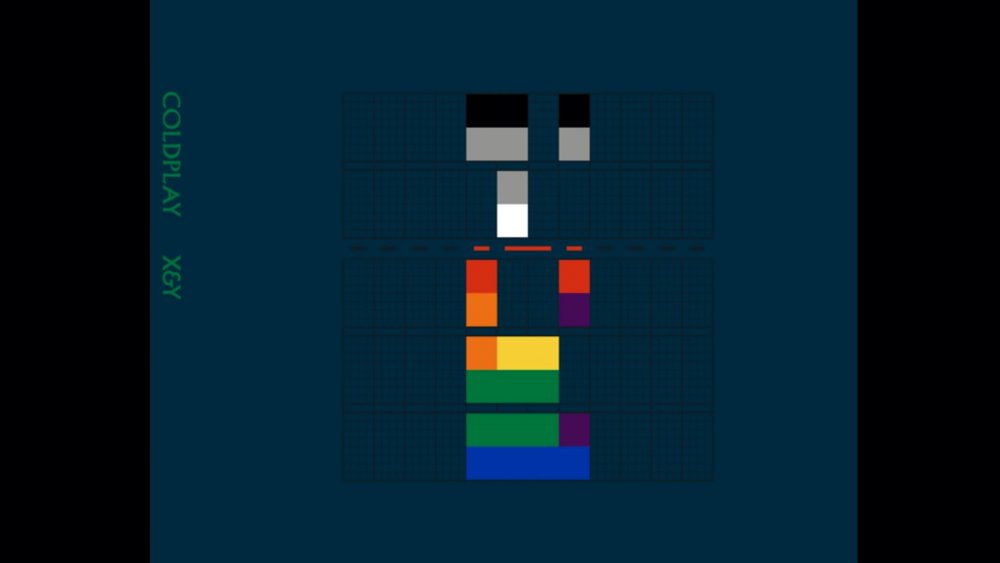The Hidden Truth Behind Coldplay's X & Y Album Cover
Coldplay's X&Y, released in 2005, boasted quite a few popular songs. It's the album that featured "Fix You" and "Speed of Sound," after all. But X&Y remains popular five years on, not just because "Fix You" was everywhere for a few years.
You see, X&Y has a hidden meaning. Or at least, its album cover has hidden meanings. The X&Y cover features a multi-colored Tetris game in the middle of a dark blue background. When the album was first released, MTV said people didn't understand what was going on in the album. Was Coldplay just closet Tetris fans or something? It wasn't until the band teased that there was something deeper that people started staring at it intently.
The cover art was designed by graphic artists Mark Tappin and Simon Gofton of the team Tappin Gofton. Design Observer explained the duo created the Chemical Brothers' cover art for their album Push the Button. For Coldplay's cover art, the two deliberately moved away from the more familiar art used by other designers. They used the color code to get people interested enough to try and decipher any hidden meanings. X&Y's cover was something of interest to art critics back then, calling it more than a puzzle and more of an art piece. Graphic artists and graphic art fans looked at the cover and liked how it managed to provoke emotions and study, something that very rarely happens with record design.
The hidden code
Once the cover came out, Coldplay promised the whole thing would make sense. So people started looking for meaning. Is it in the colors? Does it mean anything that a gray block is about to land on color? Is it because the album is kind of sad? The Guardian reported, however, the colors don't matter at all. Instead, one must learn the Baudot Code to decipher the album cover's meaning.
The Baudot code was developed and patented by Émile Baudot in 1874, explains MTV. It's a form of communication using a series of zeroes and ones, kind of how computers use ones and zeroes to communicate digitally. The Baudot code was the most widely used method of telegraph communication for at least 70 years before the Morse code was introduced. Baudot assigns "bits" for each letter. As MTV illustrates, 11000 is A, and 10011 is B, and so on. It also codes numerals and symbols. It's a whole system that includes how to differentiate between numbers and letters.
To help people read a code that hasn't been used since the 19th century, Coldplay released a chart that pretty much functioned as a cheat sheet to decipher the album's message. The cover itself is a graphic representation of the Baudot code. Once this became clear, people set about trying to figure out what exactly lead singer Chris Martin and his band wanted to say. You'd think music fans were detectives with how seriously they took this challenge.
Okay, so what does it all mean?
So how did the album get deciphered? The Guardian explained: Each column represents a letter in the Baudot code.
The first column of colors, the black and grey block, is a 1. The gap is a zero, and the three blocks of color give a series of three 1s. As for the next columns, the second column is Baudot's shift key, or how the code puts a space between letters and numbers, 11011. The third column points to a symbol, the ampersand, or &. You get where this is going, right? The Tetris blocks spell out the title X&Y. Yes, after learning a whole new code, that's all it says. Talk about all that work for something that's so obvious.
MTV did note that the album cover yields other surprises. The liner page's image spells out "Make Trade Fair," an organization Martin supports that aims to eliminate Third World debt by reforming trade laws. The band continued to use the Baudot code for subsequent single releases, but people probably didn't bother to go through all of the trouble to figure out if the symbols meant "Fix You" or "Speed of Sound." Either way, Coldplay's X&Y intrigued people far beyond the amazing songs in the album.


